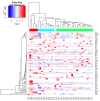Cell-Free DNA Variant Sequencing Using Plasma and AR-V7 Testing of Circulating Tumor Cells in Prostate Cancer Patients
- PMID: 34831445
- PMCID: PMC8620951
- DOI: 10.3390/cells10113223
Cell-Free DNA Variant Sequencing Using Plasma and AR-V7 Testing of Circulating Tumor Cells in Prostate Cancer Patients
Abstract
Prostate cancer (PCa) is the second most common malignant cancer and is a major cause of morbidity and mortality among men worldwide. There is still an urgent need for biomarkers applicable for diagnosis, prognosis, therapy prediction, or therapy monitoring in PCa. Liquid biopsies, including cell-free DNA (cfDNA) and circulating tumor cells (CTCs), are a valuable source for studying such biomarkers and are minimally invasive. In our study, we investigated the cfDNA of 34 progressive PCa patients, via targeted sequencing, for sequence variants and for the occurrence of CTCs, with a focus on androgen receptor splice variant 7 (AR-V7)-positive CTCs. The cfDNA content was associated with overall survival (OS; p = 0.014), disease-specific survival (DSS; p = 0.004), and time to treatment change (TTC; p = 0.001). Moreover, when considering all sequence variants grouped by their functional impact and allele frequency, a significant association with TTC (p = 0.017) was observed. When investigating only pathogenic or likely pathogenic gene variants, variants of the BRCA1 gene (p = 0.029) and the AR ligand-binding domain (p = 0.050) were associated with a shorter TTC. Likewise, the presence of CTCs was associated with a shorter TTC (p = 0.031). The presence of AR-V7-positive CTCs was associated with TTC (p < 0.001) in Kaplan-Meier analysis. Interestingly, all patients with AR-V7-positive CTCs also carried TP53 point mutations. Altogether, analysis of cfDNA and CTCs can provide complementary information that may support temporal and targeted treatment decisions and may elucidate the optimal choice within the variety of therapy options for advanced PCa patients.
Keywords: CTCs; cfDNA; prognosis; prostate cancer; sequence variants.
Conflict of interest statement
S.H. and M.G. are employees of Qiagen, Hilden, Germany. The authors declare that there are no other financial and/or nonfinancial conflict of interest.
Figures








References
Publication types
MeSH terms
Substances
Grants and funding
LinkOut - more resources
Full Text Sources
Medical
Research Materials
Miscellaneous

